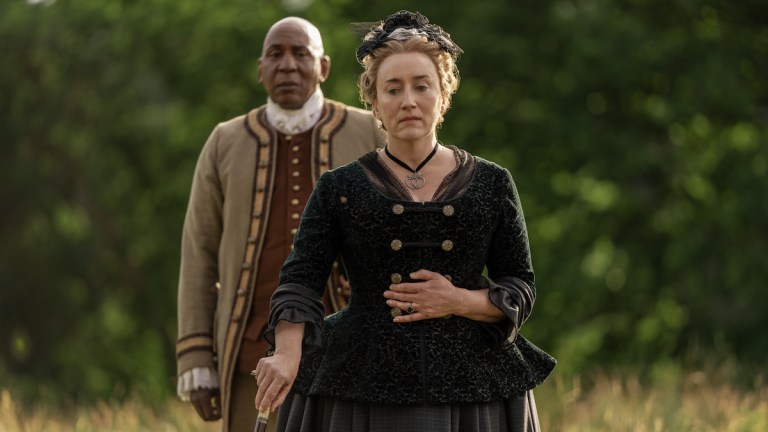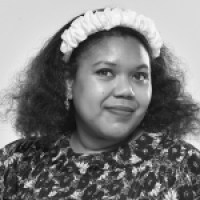Outlander: We Need to Talk About Jocasta Owning Slaves
Outlander Season 5 has devoted a lot of screentime to Jocasta, but not enough to discussing the slaves behind her riches at River Run.

This Outlander article contains spoilers through Season 5, Episode 8.
Outlander fans know Jocasta as Jamie Fraser’s incredibly rich aunt who built an entire estate off of stolen Jacobite gold. Underneath the estate’s pretty exteriors, however, is a truth the series so far has done the utmost to avoid having any serious discussion about: African slaves built the house, planted the crops, and served all of the guests at Jocasta’s Season 5 wedding to Duncan Innes.
This isn’t the first time Outlander has side-stepped the issue of slavery, nor will it probably be the last. Since the show made its way to the Americas in Season 3, the writers’ consistent failure to address slavery has been a disservice to fans of all ethnicities. It also creates a disconnect between the show and its source material. There are easy solutions to this problem, but it would take the current writing staff admitting that slavery is one of their blindspots to even begin addressing them.
Outlander’s trend of ignoring slaveholding begins in Season 3’s run of Jamaica-set episodes. Jamie and Claire “buy” a slave to free the man. From the get-go, the moral and practical problem of funding the slavery system is completely ignored. As Claire is far more concerned about finding Ian, her dialogue gives only a cursory protest about the purchase. This is in stark contrast to the Outlander novels.
Some of the other scenes in the Jamaica-set episodes show slaves as faceless entities sweating in the sun. The scenes with the Maroons depicted the runaway slaves as exotic and violent, missing the opportunity to humanize them in any way. As a woman of Carribbean-American descent, these episodes did not do the history of my ancestors justice, and the same can be said of African-American fans for many of the Jocasta-centric episodes.
Diana Gabaldon gets partial credit in the novel series for going into extensive detail about what was underneath River Run’s pretty white stucco. Readers of Voyager, Drums of Autumn, and The Fiery Cross were introduced to slaves, freedmen, and runaways in Jamaica and South Carolina. We see Claire, Roger, and Bree actively question 18th century views on slavery at different points in the book series. Jamie’s mind is changed on the issue during his experiences as a prison laborer, and because of Claire’s modern racial awareness. In light of the New York Times’ 1619 Project and other works from Black historians about this era, some of the book’s plotlines fall short. However, the novels do not pretend slavery is an issue not worth discussing.
Unfortunately, this is not the case for the TV adaptation. Some of the most recent episodes “Better To Marry Than To Burn,” for example, have several glaring examples of Outlander sidestepping slavery altogether. Jemmy, who can do little more than walk two feet to catch a ball, is now the sole heir to River Run. This ownership includes all of the slaves Jocasta currently owns. Roger and Bree so far have only objected to this development in terms of establishing Jemmy’s paternal identity. This directly contradicts Bree actively voicing concerns over Jocasta’s affairs at River Run in Season 4. The contradiction sets up the show as only featuring anti-slavery protests when it is the easy thing for the 20th century characters to do. We see so much of Roger moping about how he can survive in the 18th century, but we don’t see him use his intelligence to help a slave take their freedom, which does happen in the novels.
Outander also ignores chances to depict how deeply embedded slavery was in southern society. In “Better To Marry Than To Burn,” the show sidesteps any visual or dialogue description of how Jocasta’s slaves would have had put in weeks of work to prepare River Run for the wedding. Not only does the pre-wedding reception ignore how all of those decorations were likely set up by slaves, many of the guests would have likely brought their own slaves to attend to them. Slaves would have helped their mistresses lace up their stays (corsets) and assisted their masters in smoothing out their suits. Jamie and Claire would likely be the only wedding guests who would have refused Jocasta’s offer of lending a slave or bringing their own.
In addition to ignoring historical realities that would develop the settings, the Outlander TV show has a problematic adaptation trend of either dropping characters of color or diminishing their storylines from the books. In the novels, Ulysses has a whole backstory that is explored in detail, with many of those events unfolding during Jocasta’s wedding. In the most recent episode, “Famous Last Words,” as well as other episodes in Season 5, Ulysses only speaks when he’s acting as Jocasta’s eyes. Some fans even go as far as to describe him as a “trusted servant” when he is still, indeed, a slave.
In the novels, Phaedre is a key character in the wedding preparations. Her lighter skin tone compared to Ulysses likely indicates her father was one of Jocasta’s overseers. Overseers were well known for not only administering beatings to field slaves, but also raping slaves. There are mentions of harsh conditions slaves faced but never one about the people at River Run or other plantations in charge of administering beatings to slaves. Actors often accept other gigs, but if Outlander deemed these characters important enough, they could find a way to keep them employed.
Manoke is a character of color who arguably didn’t even make it from the books to novels. Remember when Brianna stumbled upon Lord John Grey making love to a slave in Season 4? He was supposed to represent the book series’ Manoke, an indigenous character who went from being Lord John Grey’s paid cook to his lover. Manoke’s background also highlights how the show also chooses to side step race issues around indigenous characters and communities. Readers can see the development of Manoke and John Grey’s relationship through the novel series as well as Manoke’s appearance in some of the Lord John Grey spinoff works. These stories, even if not necessarily written in linear order, make it clear the servant-master dynamic is more a cover against homophobia than any attempt to justify racism, a nuance that is missing in the TV series.
Speaking of sexual dynamics around slavery, Season 5 discussion around Fanny Beardsley’s baby avoids any mention of her mixed race identity. None of the characters express much concern about how the Browns are going to actively ensure she will be treated well when she grows and the features of her father, who is simply identified as a “runaway slave,” become more apparent. In the novel series, baby Bonnie has her own subplot. Meanwhile, during “The Company We Keep,” the conversation around her future centers around how mean Mr. Beardsley was and how sad it is that Fanny ran away. The erasure of Fanny’s baby is reprised several episodes later, during the “The Ballad of Roger Mac,” when the Brown family violently reacts to Isaiah’s return to the militia after “living in sin” with Alicia. Jamie doesn’t question how these events will affect Fanny’s because he’s so focused on the battle.
The fiery cross from the Season 5 premiere is also steeped in the history of slavery. When the key art was released, interviews with the production team stressed making sure the cross was shaped “celtic” style, with the circle in the middle, but there was no mention of why the distinction had to be made. Southern racists of Scottish descent who joined the Ku Klux Klan “borrowed” the clan call to battle to intimidate blacks, Catholics, Jews, and immigrants. The burning cross as a symbol of racial terror would be very familiar to Claire, Roger, or Bree. No one protested or even quietly expressed confusion about why Jamie would do the same thing as the KKK.
Outlander doesn’t always avoid the subject of slavery. Season 4’s “Do No Harm” is actually a good example of the show highlighting slavery. Claire is actively horrified by the conditions of Jocasta’s slaves. Her protests are not the easy way out of the situation. Jamie questions Jocasta about how the rice is grown. Rufus, a slave who was “convicted” by the white mob for murdering a man, receives medical assistance from Claire despite the danger to her life and his. The end of the episode shows how lynching was a problem even in the 18th century. Some fans did question how the episode treats the issue, but it was the most comprehensive episode on slavery in the show’s entire history to date.
What can be done to fix the problem? While Season 5 is already finished filming, Season 6 is still in development. Outlander, a very successful property for Starz, could easily afford experts in Black History to consult on episode scripts. The show brought on consultants for the Cherokee/Tuscarora plots in Season 4, showing that it can be done. And once these consultants are brought on, the writers would hopefully use them as a resource in the difficult process of rewriting book plots to avoid offensive connotations.
Hiring a black screenwriter (or more than one) would be the ultimate solution to the problem of the perception of Outlander not being concerned with the point of view of black people. Not only could these writers contribute meaningful reactions to the ideas of other writers in the room, their own scripts can balance adapting the novels with highlighting their innate experience of what it is like to exist as a Black person in this world. The greater the effort to make sure they are not reduced to being the “token” voice in slavery or racism centric episodes, the more sucessful the writers’ room would be overall.
Within the Outlander fandom, fans should take heed when Black fans and other people of color express concerns over the show and books presenting problematic history. “But that’s what was in the novels” should not be used as a weapon to silence within-the-fandom dissent on race issues. White fans and non-black people of color who struggle with admitting their ancestors benefitted from slavery and institutionalized racism against blacks should not be allowed to derail or censor discussions on slavery-centric plots as well. People who claim the real-life Scottish (and sometimes Irish) indentured servants the Beardsley brothers represent were victims of “white slavery” should not be tolerated as their “evidence” is steeped in white supremacist propaganda and not credible research from historians.
My main wish for the second half of Outlander Season 5 is that at least one subplot explicitly (not implicitly) refer to the history of slavery in North Carolina. There is so much material from real history or the books that the scripts can draw from. This show has an incredible opportunity to spread empathy about the history of slavery through fiction, and it does viewers of all backgrounds a disservice if it is wasted.
Note: For Outlander fans looking for more perspectives from women of color, I highly recommend my colleagues in fandom the Blacklanderz blog on Twitter and their episode commentaries here.
